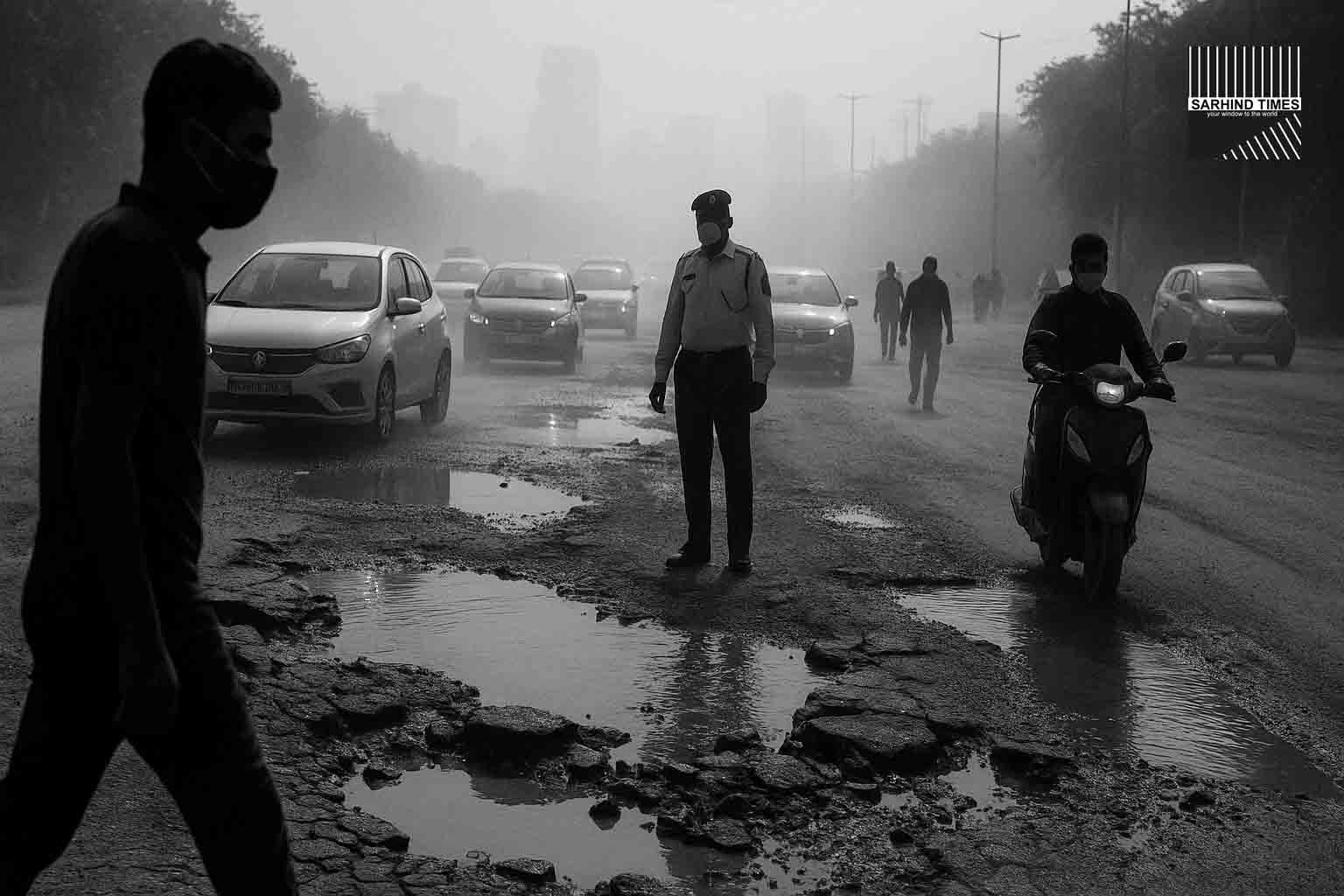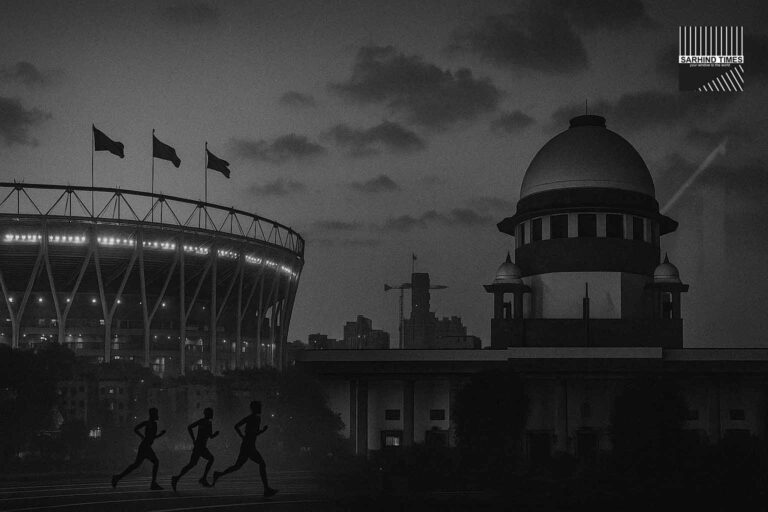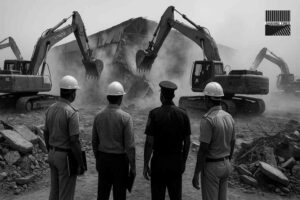Residents slam civic apathy as cratered stretches turn daily travel into endurance tests. GMDA claims repairs are underway, but citizens demand faster, smarter road management.
Gurgaon | October 11, 2025
For millions of Gurgaon residents, daily commuting has become a battle of endurance, dust, and delay. Once envisioned as a futuristic city of glass towers and expressways, India’s millennium city now finds itself navigating an older, familiar foe — broken roads.
From Agrasen Chowk to Jharsa, Subhash Chowk, and the Mehrauli–Gurgaon Road near Sector 14, stretches that were once arterial lifelines now resemble patchworks of craters. Motorists swerve and brake every few metres; bikers risk skidding into potholes hidden beneath muddy water. The chorus of honks, coupled with plumes of dust, tells the story of a city choking on its own infrastructure.
“Every ride feels like off-roading,” laughs Vikram Yadav, a daily commuter from Sector 9, “except it’s not funny when you’re late for work or when your kid’s school bus hits a pothole.”
The Scene on the Ground
A drive across Gurgaon paints a grim picture. The Mehrauli–Gurgaon Road, which connects the city to South Delhi, is lined with uneven asphalt and half-repaired trenches. Near Sector 14, a large crater has forced vehicles into a single lane, creating half-kilometre bottlenecks during peak hours.
At Jharsa Chowk, where traffic merges from three directions, a combination of broken road edges and pooled rainwater regularly leads to chaos. Commuters say even short distances now take twice the time.
“The rain stopped weeks ago, but the roads look like they were bombed yesterday,” said Ritu Sharma, who commutes daily from Sector 56 to Cyber City. “Dust rises from every passing vehicle, coating shopfronts and choking pedestrians.”
Meanwhile, Subhash Chowk, a crucial junction connecting Sohna Road and Hero Honda Chowk, remains a hazard zone. Trucks and cabs jostle for space, and the absence of lane markings worsens confusion.
A City Built on Speed, Now Slowed by Potholes
Gurgaon, known for its towering offices, luxury apartments, and gated communities, once symbolized modern India’s rapid urban leap. Yet, ironically, that very speed has turned into its nemesis.
Overloaded construction trucks, years of neglected maintenance, and heavy monsoon runoff have weakened the base layers of major roads. Experts point out that the city’s asphalt is stretched beyond capacity — both literally and figuratively.
“Most roads in Gurgaon were not designed for today’s volume and axle load,” said Dr. Ankit Malik, a civil engineer at the National Institute of Road Development. “When you have container trucks and dumpers regularly using urban roads, micro-cracks expand into potholes within weeks if not repaired swiftly.”
The delayed withdrawal of monsoon this year made matters worse, keeping roadbeds damp and hindering resurfacing efforts.
GMDA’s Response: Repairs in Progress
Officials from the Gurugram Metropolitan Development Authority (GMDA) say they are aware of the situation and that repair work has already begun in key stretches.
“We’ve started patch repairs at multiple chowks,” said a GMDA spokesperson. “Bitumen mixing plants are running, and with clearer weather, resurfacing will accelerate. Our goal is to complete the high-priority corridors before Diwali traffic peaks.”
According to GMDA, a list of 34 critical roads has been finalized for immediate attention. The list includes Mehrauli–Gurgaon Road, Golf Course Road, Subhash Chowk, Jharsa Road, and the Old Delhi–Gurgaon Road.
Officials added that limited manpower during the monsoon and supply delays in road materials contributed to the backlog. “We’re now working in double shifts, including night hours, to reduce disruption,” the spokesperson said.
Public Outrage and Civic Fatigue
Despite official assurances, residents are losing patience. The local social media landscape is filled with videos of potholes swallowing scooter tires and memes comparing Gurgaon roads to “lunar surfaces.”
Resident welfare associations (RWAs) have filed multiple complaints, but say the city’s response remains reactive rather than preventive.
“Every year we see the same pattern — roads crumble after rains, temporary patching is done, and within months it breaks again,” said Anand Verma, president of Sector 10A RWA.
“We don’t need promises; we need accountability.”
A group of concerned citizens recently launched the online campaign #FixGurgaonRoads, tagging GMDA, the Municipal Corporation of Gurugram (MCG), and Haryana PWD. The hashtag quickly trended locally, forcing the authorities to issue public updates.
Why the Roads Keep Failing
Infrastructure specialists trace the crisis to four main causes:
- Poor Drainage: Inadequate stormwater management leaves rainwater stagnating on roads for days. Water seeps into the bitumen layers, weakening the road base.
- Substandard Material: Experts allege that in some contracts, cost-cutting results in thinner asphalt layers and poor-quality aggregates.
- Overloading: Heavy trucks often exceed permissible load limits, accelerating road wear.
- Lack of Coordination: Multiple agencies — GMDA, MCG, HUDA, and NHAI — share overlapping jurisdictions, leading to confusion and delays.
Dr. Malik noted that unless Gurgaon establishes a single-point accountability mechanism for road upkeep, these problems will persist.
Health and Environmental Fallout
Beyond traffic delays, residents are also facing serious air quality concerns. Dust generated by broken roads has worsened respiratory ailments, especially among children and senior citizens.
According to a local environmental NGO, PM10 levels along Mehrauli–Gurgaon Road spiked to nearly double the safe limit during the first week of October. “Every passing truck throws up clouds of dust; the situation is unsafe for cyclists and pedestrians,” said Priya Nanda, founder of CleanAirGurgaon.
Doctors from Artemis and Medanta hospitals confirm a surge in complaints of throat irritation, cough, and allergic bronchitis. With winter inversion approaching, the dust is likely to linger, compounding Delhi-NCR’s annual pollution crisis.
Economy and Productivity Hit
The pothole crisis is also denting productivity. Corporate employees report longer commutes, delayed meetings, and rising fuel costs. Ride-hailing apps like Uber and Ola have adjusted fares in response to longer trip durations.
Small logistics operators are among the hardest hit. “Our delivery vans are spending an extra 30–45 minutes per route. That’s lost business,” said Rohit Singh, who runs a courier service near IFFCO Chowk.
A recent survey by Sarhind Times Data Desk found that 78% of Gurgaon commuters believe road conditions have worsened over the past year. Nearly 64% said they would consider relocating offices or schools if the situation does not improve by next summer.
Comparing Civic Models
Urban planners contrast Gurgaon’s reactive road management with Pune’s proactive maintenance model, where pothole complaints are geo-tagged, monitored, and resolved within 48 hours. Similarly, Bengaluru’s “FixMyStreet” app allows real-time citizen reporting with photographic evidence.
“Gurgaon needs a similar transparent mechanism — one where every pothole report has a public timeline,” said Dr. Basu, a transport researcher. “We must move from firefighting to prevention.”
Several citizen groups have proposed a joint GMDA–citizen dashboard, displaying live updates on road works, contractors, and expected completion dates.
Festival Season Fears
With Diwali and wedding season around the corner, traffic volumes are expected to rise by nearly 20%, according to GMDA estimates. Commuters fear that if resurfacing isn’t completed soon, the festive rush could lead to gridlock.
“Imagine Lakshmi Puja traffic combined with potholes — Gurgaon will come to a standstill,” joked commuter Suresh Narula, who drives from Palam Vihar to Cyber Hub.
Shopkeepers along Subhash Chowk are equally worried. “Our sales drop every time it rains because customers avoid the flooded road,” said Rekha Sethi, who runs a garments outlet.
Engineering Solutions in Discussion
Engineers recommend several measures to ensure long-lasting roads:
- Use of polymer-modified bitumen (PMB) for better water resistance.
- Concrete reinforcement for high-traffic intersections.
- Night-time repair windows to minimize congestion during work hours.
- Annual pre-monsoon audits to plug weak sections before rainfall begins.
- Penalty clauses for contractors if roads fail within 12 months of resurfacing.
A GMDA engineer confirmed that a proposal to introduce Performance-Based Maintenance Contracts (PBMC) is under review. “This will make contractors responsible for the health of roads over a defined period,” he said.
Voices from the Streets
The frustration among Gurugrammers has become both emotional and civic.
“We pay some of the highest property taxes in Haryana,” said Sonal Mehra, an HR executive. “Why are we driving on roads that look like village trails?”
“The dust gets into our eyes every day. Even traffic cops can’t stand at the chowks for long,” added Manish Arora, a food delivery worker.
Despite these hardships, a section of residents acknowledges that the city’s complex growth makes maintenance challenging. With new sectors opening every quarter, roads often lag behind real estate development.
Political Undertones
As the civic crisis deepens, political blame games have begun. Opposition leaders have accused the Haryana government of negligence and “cosmetic governance.” BJP representatives, meanwhile, say “mega urbanization requires patience and phased intervention.”
“Gurgaon’s infrastructure is evolving; these issues are temporary,” said Rajeev Khattar, a party spokesperson. “Major road revamps are planned under GMDA Phase II.”
However, public trust remains thin. Citizens want less talk and more tarmac.
Looking Ahead: Citizens’ Wishlist
Residents have proposed a five-point plan for sustainable road recovery:
- Road Health Dashboard: Live tracking of damaged stretches.
- Dedicated Complaint App: Verified by photos and response time.
- Transparent Tendering: Public display of contractor ratings and timelines.
- Annual Quality Audit: Independent inspection before contractor payment.
- Long-Term Vision: Integration of green corridors, walkways, and cycle paths.
These proposals, if implemented, could transform Gurgaon from a reaction-driven city to a model of proactive civic innovation.
Conclusion: The Road to Accountability
Gurgaon’s journey from ambition to exasperation is a lesson in civic management. The city’s potholes are more than physical cavities; they are symbolic gaps in governance and coordination.
If the Gurugram Metropolitan Development Authority can restore its roads with consistency and transparency, it will not only ease traffic but also rebuild citizen confidence in urban institutions.
Until then, Gurgaon will continue to drive on the edge — literally and metaphorically.
#Gurgaon #RoadSafety #GMDA #UrbanMobility #Potholes #Commuters #Infrastructure #CityLife #CleanAir #Haryana #CivicAction #SarhindTimes #SustainableCities























+ There are no comments
Add yours